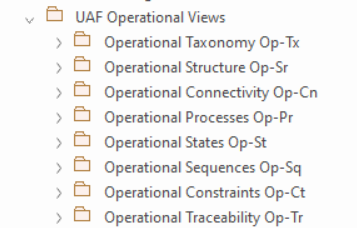| Prev | Next |
UAF Operational Views
The UAF 1.2 Operational Viewpoints provide perspectives that describe how an organization functions at a logical, business-oriented level, focusing on the operational domain as a central layer of the enterprise architecture framework. These viewpoints capture operational activities, performers, and behaviors, serving as a foundation for enterprise architecture, system-of-systems engineering, and complex systems modeling across commercial, government, and defense contexts.
Within UAF’s two-dimensional grid structure, operational viewpoints represent stakeholder concerns about how the enterprise operates, positioned alongside other domains such as strategic, personnel, resources, and services. As part of the UAF Domain Metamodel, they enable architects to design consistent operational architectures that link capabilities, requirements, and behaviors from early design through implementation, ensuring coherence in complex enterprise and system-of-systems environments.

UAF Operational Views
|
Operational Taxonomy Op-Tx |
Stakeholders: Business Architects, Systems Engineers, Enterprise Architects, Owners responsible for Operational Agents. Concerns: Operational Agent types. Definition: Shows the taxonomy of types of Operational Agents. |
|
Operational Structure Op-Sr |
Stakeholders: Business Architects, Systems Engineers, Enterprise Architects, Owners responsible for Operational Agents. Concerns: Identifies the operational exchange requirements between Operational Performers. Definition: Defines operational architecture and exchange requirements necessary to support a specific set of Capability(ies). |
|
Operational Connectivity Op-Cn |
Stakeholders: Systems Engineers, Architects, Solution Providers. Concerns: Capture the interfaces between Operational Performers. Definition: Summarizes logical exchanges between Operational Performers of information, systems, personnel, energy etc. and the logical activities that produce and consume them. Measurements can optionally be included. |
|
Operational Processes Op-Pr |
Stakeholders: Business Architect, Systems Engineers, Enterprise Architects Concerns: Captures activity based behavior and flows. Definition: Describes the activities that are normally conducted in the course of achieving business goals that support a capability. It describes operational activities, their Inputs/Outputs, operational activity actions and flows between them. |
|
Operational States Op-St |
Stakeholders: Systems Engineers, Software Engineers. Concerns: Capture state-based behavior of an operational OperationalPerformer. Definition: It is a graphical representation of states of an operational OperationalPerformer and how that operational OperationalPerformer responds to various events and actions. |
|
Operational Sequences Op-Sq |
Stakeholders: Systems Engineers, Business Architects. Concerns: Express a time ordered examination of the operational exchanges as a result of a particular operational scenario. Definition: Provides a time-ordered examination of the operational exchanges between participating nodes (OperationalPerformer roles) as a result of a particular operational scenario. |
|
Operational Constraints Op-Ct |
Stakeholders: Systems Engineers, Architects, Program Sponsors Concerns: Define operational limitations, constraints, and performance parameters for the enterprise. Definition: Specifies traditional textual operational or business rules that are constraints on the way that business is done in the enterprise. The addition of SysML parametrics provides a computational means of defining operational constraints across the enterprise or within a specific operational context. |
|
Operational Traceability Op-Tr |
Stakeholders: Project Managers, Enterprise Architects, Business Architects. Concerns: Traceability between capabilities and operational activities and capabilities and operational agents. Definition: Describes the mapping between the capabilities required by an Enterprise and the supporting operational activities and operational agents. |